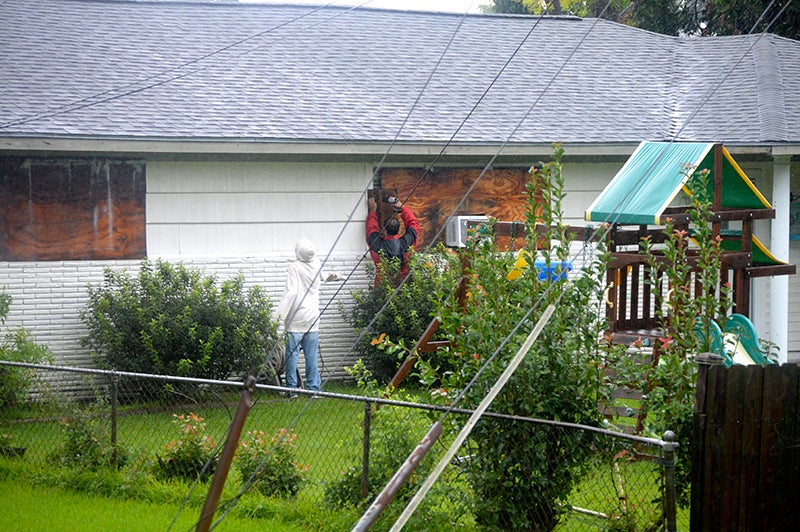Agents best advisers on storm risks
Published 12:24 pm Friday, June 1, 2018
Golf Hill homes were in the 100- and 300-year flood zone./Ken Stickney, The News
By Ken Stickney
ken.stickney@panews.com
Stuart Salter’s got a ready answer for folks who think they’re at low risk for flooding.
“In a 100-year flood plain, the chance is 1 percent of flooding every year,” Salter, with the Julian Salter Co. in Port Arthur, says. “That sounds more risky than a 100-year flood plain. The risk is the same every year. We’re all in a flood plain.”
Consider this, too: Those people living in Salter’s neighborhood off Jimmy Johnson Boulevard during Hurricane and Tropical Storm Harvey included people in a 100-year flood zone and a 500-year flood zone.
“We all flooded, just to various degrees, he said.
1-in-3 chance
Salter, who sells insurance and is a risk manager, said people who would never go without fire insurance on their homes — everyone buys that — sometimes think twice — or more — about buying flood insurance. About a quarter or less of homeowners have flood insurance, but the risk of flood here is higher than the risk of fire.
“They don’t think the risk is high” — especially if they are deemed to not live in a high-risk flood zone, Salter said. Those homeowners can buy flood insurance cheaper than their neighbors who live in higher risk areas. More often than not, they don’t.
But, Salter said, if you have a 30-year mortgage and live in a flood hazard area, there is a 1-in-3 chance of your home flooding at least once during a 30-year term.
Wind, surge, rain
With hurricane season starting Friday, it’s past time to think again if you aren’t adequately insured. An insurance agent is the best person to counsel you on that.
Southeast Texas has experienced a range of hurricane ills over the past decade and a half and it pays to be prepared for all them. Hurricane Rita in 2005 was “a big wind claim,” Salter said. In Hurricane Ike in 2008, the Texas coast experienced storm surge. And with Harvey last year came rain inundation.
Salter not only recommends flood insurance, he makes his own reluctant customers who pass on flood to sign statements noting they declined to buy it. Consider yourself forewarned.
“It’s incumbent on me to make it clear to them,” he said. “If I don’t make you aware of the risk, shame on me.”
Salter said banks require that people paying a mortgage and living in high-risk flood zones buy flood insurance. There’s no rolling the dice.
“Most of us in Port Arthur and Mid County, we live in a flood hazard area but not a special flood hazard area. There’s lower risk. They are eligible for preferred risk rates,” he said.
The National Flood Insurance, a subsidiary of the Federal Emergency Management Agency, insures homes for up to $250,000 and contents up to $100,000. The NFIP recommends that homeowners buy both; so does Salter. Where else, he asks rhetorically, can low-risk insurance customers buy $350,000 in insurance for $450 a year?
Ill winds blow
But what about wind?
“Around here, your main perils are flood and wind,” he said.
Wind insurance generally comes from the Texas Wind Insurance Association, a private, quasi-governmental entity that provides wind insurance for 13 Texas coastal counties. TWIA was created because insurers could not offer it profitably. They fled the market, leaving Texans without options for insurance.
Salter said insurers fled the wind market in 1988 because they could not charge rates that were high enough to offset losses. Texas’ Insurance Department developed TWIA to fill the gap. There have been some bumps along the way.
“Everyone is susceptible to wind,” Salter said. “That’s where construction standards come in.”
Salter said builders have built more fortified structures in the last 30 years to withstand hurricane force winds. Requirements have been developed, honed and enforced for windstorm inspections for construction or repair.
Roofs, doors and windows are the primary sources of wind intrusion, Salter said. You want to envelop your home as tightly as possible, he said, to keep winds up to 120 mph from peeling off your roof. Wind damage is expensive.
TWIA is not cheap. The upside to higher prices, Salter said, is that prices are high enough to lure private insurers back into the market. TWIA welcomed them back as a way to share costs and liability. About 90 percent of people here buy wind insurance; they all need it.
Ask your agent
Salter suggested that homeowners seek out qualified insurance agents for knowledgeable advice.
“Advice is free. Talk to your agent. They are paid professionals. They have licenses; we have requirements within Texas to be fair and honest brokers.
“Our industry is good about generating information,” he said.
Here’s some of that information:
- Wind and flood are the great perils in this area.
- Ninety percent of people have wind insurance.
- Twenty to 25 percent of homeowners buy flood insurance.
“I don’t get it,” Salter said.





